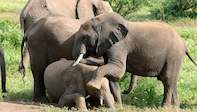
Fireside tales and anecdotal evidence of how elephants show concern for other distressed or dying elephants have been backed up by a paper recently published in a special 'Sentience in Animals' issue of the journal Applied Animal Behaviour Science. The paper is written by Save the Elephants founder Dr Iain Douglas-Hamilton and other colleagues from the organisation.
It describes the events surrounding the death of an elephant matriarch known as Eleanor in October 2003. In the Samburu area of Kenya where Eleanor lived, Save the Elephants researchers have been continuously monitoring a 900-strong elephant population since 1997.
The researchers know the animals individually and study their associations with other elephants. From recorded observations, the scientists can identify family groups and can work out which family groups tend to spend time together. For ease of reference, each family group has a theme after which all the elephants in the group are named.
For example, Eleanor came from the First Ladies, but elephants that visited her before and after her death include Grace from the Virtues, Rosemary from the Spices and Jerusalem from the Biblical Towns. By compiling all their elephant observations over the years, the researchers are able to give a statistical value of how closely elephants associate with each other.
For example, an elephant known as Maya was thought to be Eleanor's daughter. She was Eleanor's closest companion, and had an association index of 0.89 with Eleanor. In contrast, Grace spent less time with Eleanor and had an association index of 0.10.
Altogether, the researchers were able to observe 12 female elephants but no bull elephants interacting with Eleanor or her carcass in the week of her death. The elephants came from five different family groups, including Eleanor's own First Lady group.
Satellite Readings
For the three elephants, Maya, Rosemary and Jerusalem, satellite-tracking data was also available from the GPS collars that they were wearing at the time. The satellite readings back up the visual observations and photographs taken at the time of Eleanor's death, and allowed the researchers to accurately pinpoint the location of these animals during the week that Eleanor died.
Interestingly, although the data show that Eleanor's erstwhile daughter, Maya, spent significantly more time in close proximity to Eleanor's carcass than the other elephants did during the week described in the paper, Maya was not observed showing the same strong responses to the dying and dead Eleanor that the other elephants did.

On the day prior to Eleanor's death, researcher Shivani Bhalla found Eleanor in a poor condition. Bhalla saw Eleanor fall to the ground. Two minutes later another matriarch, Grace, who seldom associated with Eleanor, "rapidly approached her, with tail raised and streaming with temporal gland secretion." Obviously distressed, she tried repeatedly to lift Eleanor with her tusks, vocalising at the same time.
She stayed with Eleanor for over an hour, even after her own family moved off At this stage, Maya, who usually spent a lot of time with Eleanor, was over 1.5km away. Eleanor died the next day at about 11h00. By then Maya had returned to within 360m of Eleanor, and spent the next seven hours relatively close by, although she was only recorded as being within 10m of the body at 16h00.
Sporadic Visitor
At this stage, another elephant that was so infrequently seen in Samburu that she was listed as a "sporadic visitor" to the park, and who obviously seldom associated with Eleanor (association index 0.07), "hesitantly approached Eleanor's body, extended her trunk, sniffed the body, touched it, and then tasted her trunk.
She hovered her right foot over the body, nudged the body, and then stepped over, pulling the body with her left foot and trunk, before standing over the body and rocking to and fro." Even after rangers removed Eleanor's tusks and predators came to feast on the carcass, a number of other strong behaviours were recorded from the 12 elephants seen visiting the carcass.
These include tentative approaches to the body, sniffing the body, touching the body with their trunks and hovering their feet over the carcass. One elephant even threatened others and appeared to be guarding the body, although she was unrelated to Eleanor. Grace, who tried to lift the fallen Eleanor prior to her death, re-visited the body two days later but "did not appear to be distressed" at this visit.
Eleanor's Calf

At the time of her death, Eleanor had a six-month-old calf, who died within three months of Eleanor's death. Although she seemingly spent these months with Maya and the rest of Eleanor's calves, "none of the breeding females normally associated with Eleanor were observed to suckle the youngest calf despite its attempts to suck lactating females."
With these observations of elephants from five different family groups, most of which were not related to Eleanor, showing a distinct interest in her body, the authors of the paper conclude that "elephants are interested in the sick, dying or dead elephants irrespective of genetic relationship." "The case is made that elephants, like human beings, can show compassionate behaviour to others in distress." Other species recorded to show similar behaviour are chimpanzees and dolphins.

